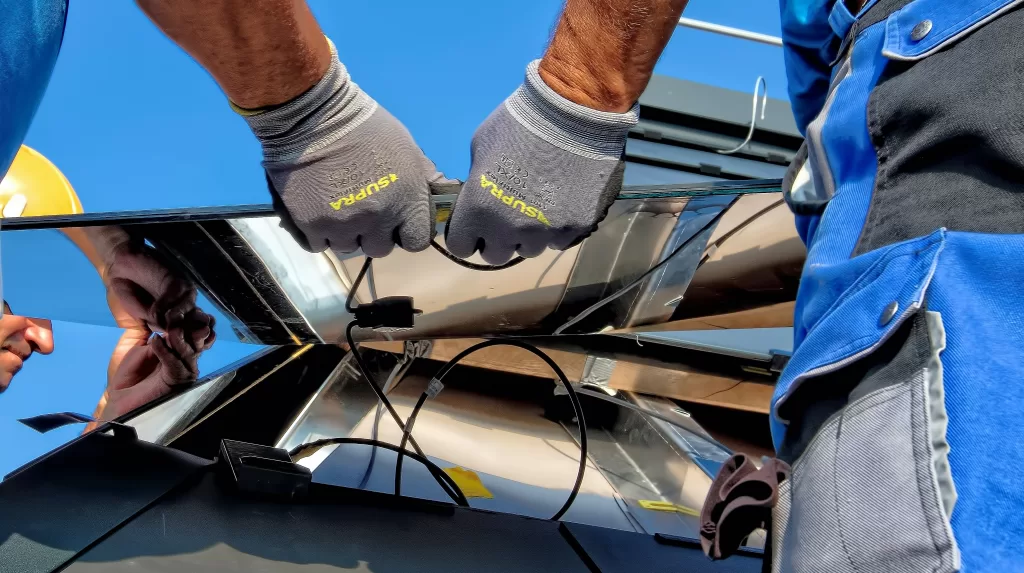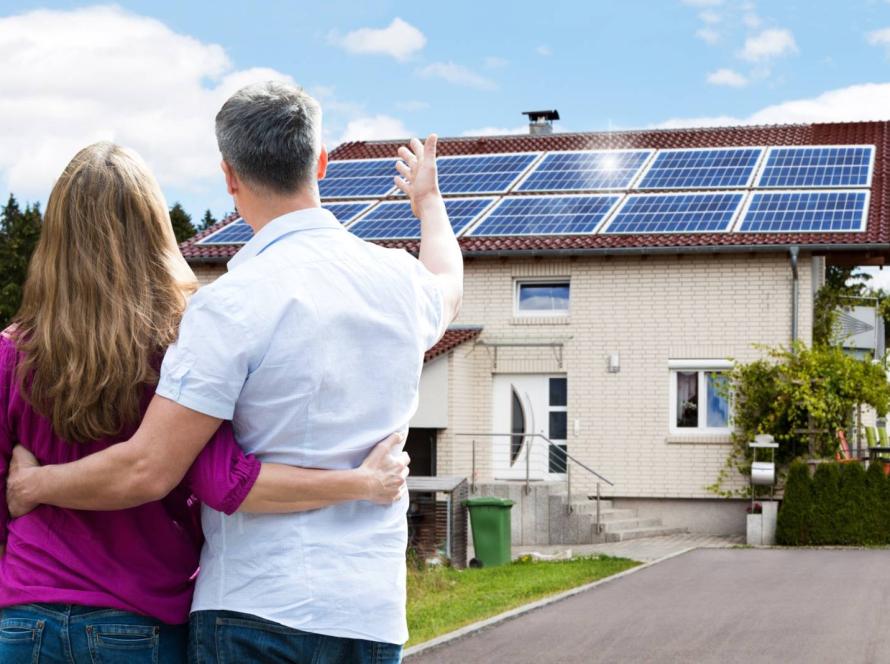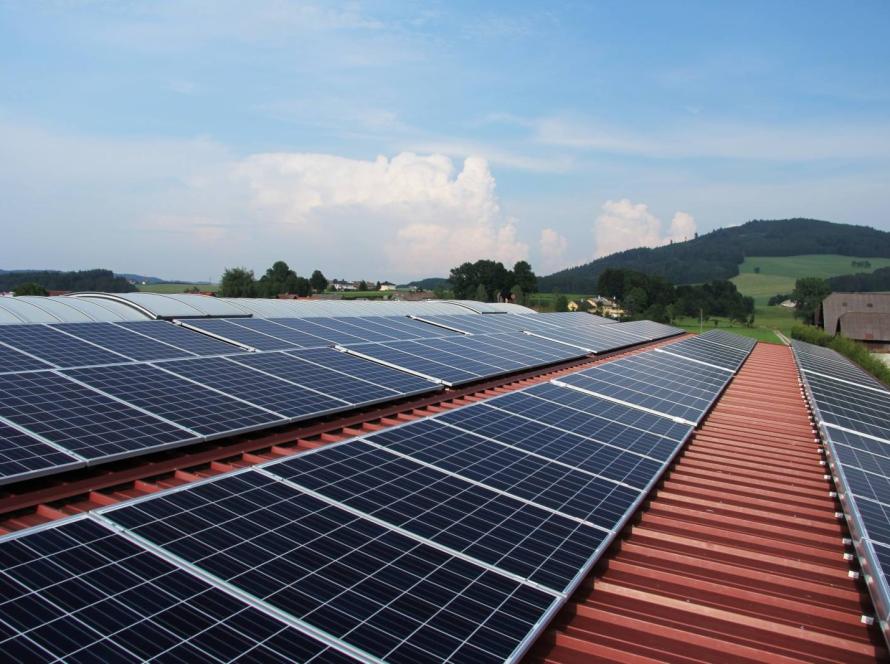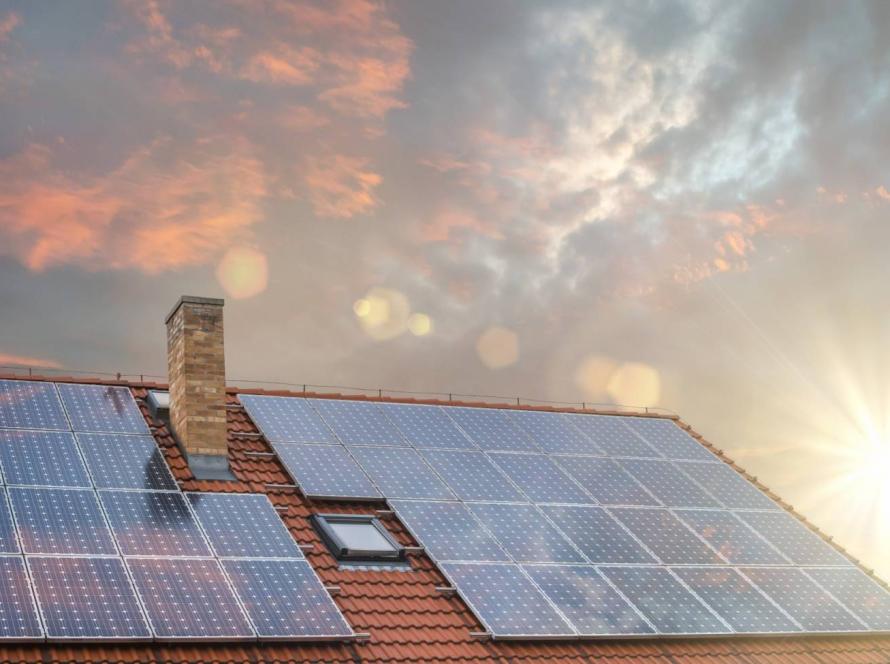Everyone knows that solar is a great way to generate clean energy for your home, but not many know how they work. No, it’s not magic; it all has to do with the photovoltaic effect. That might sound fancy, but it’s actually a straightforward process used to power over 18.6 million U.S. homes!
If you’ve ever wondered “What are solar panels, and how do they work,” here’s your guide to the science behind renewable energy for your home.
Solar Panel Basics

What are solar panels? They’re silicon crystals that absorb sunlight and convert it into usable electricity.
You might think they’re a recent development, but solar panel development actually began way back in 1839. A French scientist discovered the photovoltaic effect, which is a process that creates electricity when a substance is exposed to sunlight. Over time, scientists discovered how to harness the electricity created, and solar panels were born. By 1970, they were used to power small devices, like calculators. Now, they power everything from boats, RVs, and cars to entire homes and cities.
Solar panels work by converting sunlight into electricity in four basic steps:
- Silicon in the panels absorbs sunlight, which creates an electric field.
- The electricity flows to the panel’s edges and into conductive wire.
- The wire transfers the direct current (DC) energy from the panel into an inverter that converts it into alternating current (AC) energy that can be used in your home.
- Another wire takes the usable AC energy and sends it either directly to your home, into a solar battery, or back to the power grid, depending on how the solar panel system is laid out.
This process isn’t perfect, yet. Modern solar panels aren’t able to convert 100% of the sunlight into clean, usable energy. Typically, a high-efficiency solar panel can convert around 20% of the sunlight it absorbs into power. A panel’s efficiency depends on how it’s made, the quality of the parts, and how the system is set up.
The Three Types of Solar Panels
Solar panels can be broken down into three different types:
- Monocrystalline
- Polycrystalline
- Thin film
There are pros and cons to each type, so it’s important to understand the differences to help you choose the one that’s right for your specific situation.
Monocrystalline
Monocrystalline solar panels are cells cut from a single, pure silicon crystal. Because it’s cut from a single crystal, monocrystalline panels are purer and have higher energy efficiency compared to other types. It’s not uncommon to find monocrystalline panels with efficiency ratings of 20% or higher!
In addition to the higher efficiency rating, monocrystalline panels can also hold more power, some even up to 400-watts and beyond. They’re by far the most efficient and high-performing solar panel on the market.
The main downside to monocrystalline solar panels is the cost. Creating an entire panel out of a single crystal is highly energy-consuming and leaves wasted silicon, making it very expensive to produce. If you don’t have much space and need to make the most of it, monocrystalline panels are a good choice.
Pros
- Most efficient
- High performance
Cons
- Expensive
Polycrystalline
Remember that leftover silicon from producing monocrystalline solar panels? Luckily, it’s not wasted; it’s just made into another type called polycrystalline.
As the name might suggest, polycrystalline panels are made of fragments of silicon crystals all melted together to form a single panel, then cut into cells. Since the panel isn’t a single, pure piece of silicon, the process of creating a polycrystalline panel does reduce some of the efficiency.
While monocrystalline panels have efficiency ratings of around 20%, polycrystalline panels typically land somewhere between 15% and 17%. They also tend to have lower wattage capacities compared to their single-crystal buddies.
However, since polycrystalline panels are cheaper to manufacture, those savings get passed on to you! What polycrystalline panels lack in efficiency, they make up for with cost-effectiveness. They’re a much cheaper alternative compared to monocrystalline panels.
If you have plenty of space to fill with solar panels, polycrystalline is a great option to help you cut some costs without hurting overall efficiency.
Pros
- Lower cost
Cons
- Lower efficiency and performance
Thin-Film
Thin-film solar panels have a much different composition than mono or polycrystalline panels. Instead of silicon crystals, most thin-film panels are made from one of three materials:
- Cadmium telluride (CdTe)
- Amorphous silicon (a-Si)
- Copper indium gallium selenide (CIGS)
A thin layer of photovoltaic material lays between flexible, transparent layers that help capture sunlight. The result is a lightweight, thin, bendable solar panel! Some thin-film panels are as thin as 50 millimeters!
While they might be the most versatile because of their low weight, small size, and unmatched flexibility, thin-film panels are also the least efficient. Most thin-film panels have an efficiency rating around 11%.
Typically, thin-film panels are the cheapest install because they’re so easy to maneuver. They’re also perfect for buildings with roofs that can’t support a lot of weight, like large flat-topped commercial buildings. They’re not a common choice for residential applications.
Pros
- Lower cost
- Flexible
- Lightweight and portable
Cons
- Lowest performance and efficiency
Components in a Solar Panel System

Installing a solar panel system isn’t as simple as putting a few panels on the roof. There are a few components that all work together to bring clean, renewable energy into your home.
If you’re thinking of going solar, there are four components you’ll need to install to ensure you system works at optimal efficiency:
- Solar panels – the actual panel that converts sunlight into direct current electricity. (Also called solar photovoltaic panels)
- Racking and mounting systems – the braces and brackets that support the panels and attach them to the roof of your house (or wherever else you install them).
- Inverters – devices that convert DC electricity into usable AC electricity.
- Performance monitoring systems – a way to track and monitor the health and output of your entire solar panel system.
Solar Panels
Solar panels are made of silicon solar cells covered with a sheet of glass and supported by a metal frame. When sunlight hits the cells, the energy activates electrons which flow through the wiring behind the cells and into the rest of the system.
Most solar panels are about 4×6 feet and weigh about 30-pounds. They can contain either one big silicon crystal (monocrystalline) or several smaller crystals (polycrystalline). The crystal(s) gets divided into cells. Each cell captures a bit of sunlight and converts it to energy. The more cells working together, the more efficient the panel.
Most solar panels come in either 60- or 72-cell formats. The more cells a panel contains, the higher the efficiency. Of course, more cells also means more weight and space. 60-cell panels are typically for residential applications where space is limited, while 72-cell panels are mostly commercial. Manufacturers are also starting to laser-cut cells in half to create even more efficient panels with 120 and 144 cells.
Racking and Mounting Systems
The racking and mounting system is the hardware that holds your solar panels in the optimal position. They are either roof-mounted (the most common for residential applications) or ground-mounted.
To optimize performance and efficiency, you want your panels to face south and angled at 35 to 45 degrees, depending on your latitude. You can face east or west, but you’ll lose between 10% and 20% efficiency.
There are two types of mounting systems you can choose for your solar panels:
- Fixed mounts – Solar panels are locked into position and can’t move. These are the most common and cost-effective type of mount. Lie-flat systems are most common in residential applications, in which the panels mount parallel with the roof of your house.
- Tracking mounts – Solar panels can move to “track” the sun as it makes its way across the sky. These types of mounts are the best for performance, but they’re also quite expensive. You can choose between single-axis tracking mounts, which move in one direction, or dual-axis tracking mounts that follow the sun in all directions.
Generally, fixed mounts are ideal for homeowners on a budget or anyone who wishes to mount solar panels on the roof of their house. Although tracking mounts offer the best performance, they’re only for ground-mounted solar applications.
Inverters
When a solar panel absorbs energy from the sun, it comes in the form of direct current (DC) electricity. Unfortunately, this type of energy can’t power your home’s appliances. So, to make the energy usable, it needs to go through an inverter that converts it into alternating current (AC) electricity.
There are two basic types of solar inverters that you can install in your home: string inverters and micro inverters:
- String inverters (centralized) – All the solar panels in the system connect to a single inverter. Since there’s only one inverter, this is typically the least expensive option for homeowners on a budget. It’s also the most common on residential solar panels systems. However, since all the panels are connected in a string (hence, the name), if one panel is experiencing limited performance, like if it’s in the shade, it’ll affect the performance of the entire string.
- Microinverters – Instead of one centralized inverter for the entire system, each solar panel has its own microinverter that sends energy to a central wire. This allows each panel to maximize power production. Microinverters are best in shaded areas or if not all your panels face the same direction, because it minimizes performance issues. Since there are more inverters in the system (even though they are “micro”), this style of solar panel system is more expensive than a string inverter layout.
- Power optimizers – Power optimizers are the happy medium between sting inverters and microinverters. With this layout, each solar panel has a power optimizer that enhances the DC electricity before sending it to the central inverter. This helps level out performance issues like shading without the cost of installing separate inverters at each panel. This layout costs more string inverters but less than microinverters.
Performance Monitoring Systems

It’s always a good idea to keep tabs on your system’s performance. Of course, you can’t just wait for the lights to flicker before realizing there’s an issue. That’s why performance measuring systems are a vital part of any solar panel system.
Performance monitoring systems give you feedback about the overall performance of your solar panel system as well as metrics about how much energy your system produces on an hourly basis. Keeping an eye on this information can help you catch performance issues and maximize the efficiency of your system. In other words, you can maximize the return on your investment!
Generally, there are two types of monitoring systems for solar panel systems:
- On-site monitoring – The monitoring device is installed at your house and keeps track of all the information on-site. When you want to look at your data, simply look at the device. It does cost extra to install the physical equipment at your house.
- Remote monitoring – The solar panel system transmits data to a monitoring service that keeps track of your information remotely. You can then access the information online. While you won’t have to pay to install a physical monitoring device, remote monitoring does typically have a monthly subscription.
Most solar panel systems come with a production monitoring app that lets you track performance right from your mobile device. Some applications even offer consumption monitoring, so you can see how much money you’re saving on your energy bills.
Thinking of Going Solar?

Compare Quotes from Top-rated Solar Contractors in your area.
Now that you understand what solar panels are and how they work, is it time for you to go green and harness the power of the sun for your house? Solar panels are a great addition to any home to provide clean, renewable energy and provide some relief on your utility bills.
Need some extra help Tell us a little about your project, and we’ll even help you find qualified contractors in your area.





Facebook
Comments